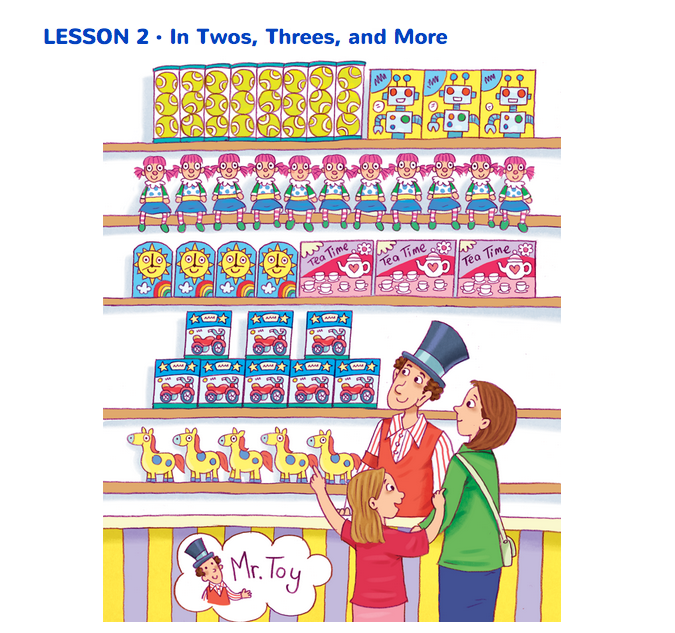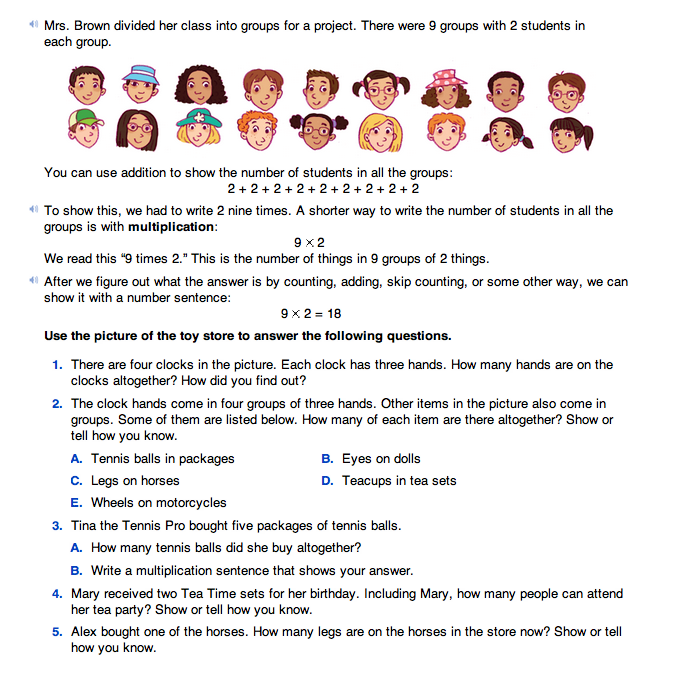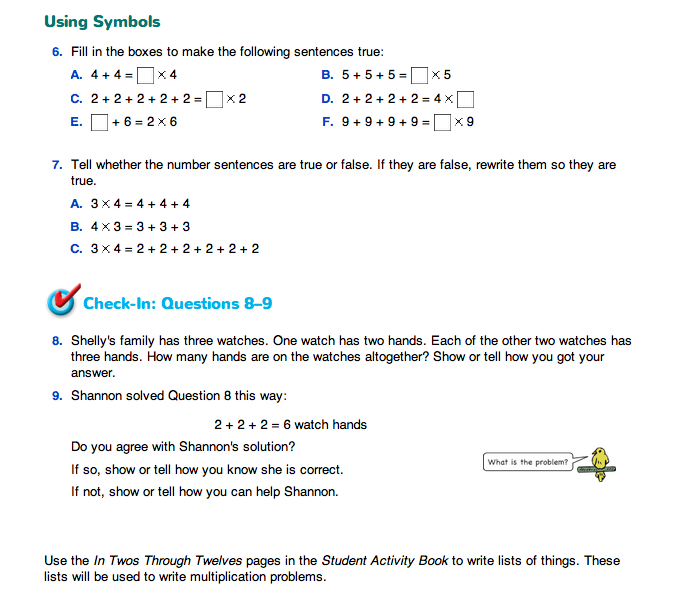In Twos, Threes, and More
Est. Class Sessions: 3Developing the Lesson
Part 1. Show Solutions to Multiplication Problems
Find Things That Come in Groups.
Begin by involving the class in a discussion:
Use larger numbers as students seem ready for them.
As students answer the questions, ask how they arrived at their answers. Encourage others to share additional solution methods. As students describe their methods, write number sentences that display their results.
For instance, one way to solve the question “How many shoes are there on six children?” is to use repeated addition: 2 + 2 + 2 + 2 + 2 + 2 = 12 shoes. This problem can also be solved by skip counting by twos. In one class, students suggested acting out the skip counting: each stood up one at a time while the class counted their shoes—2, 4, 6, 8, 10, 12. When discussing the solutions, focus on the fact that the shoes can be counted in six groups of two. Use the related multiplication sentence: 6 × 2 = 12 shoes.
Represent Solution Strategies. After discussing these problems, ask the class to turn to In Twos, Threes, and More in the Student Guide. Read and discuss the vignette with the class. Direct the students to solve Question 1. After students have worked on the question, ask a volunteer to give his or her solution while you display the number sentence stated.
Elicit additional solutions by asking:
Display all responses. Possible responses might include:
- 3 + 3 + 3 + 3 = 12
- I skip counted: 3, 6, 9, 12
- I did times: 4 × 3 = 12
- I did times, too, but mine's different: 3 hands × 4 clocks = 12 hands
- I counted each hand.
Ask:
Lead students to understand that adding labels such as 3 hands and 4 clocks would make the thinking in the solution more easily understood by others.
Then ask:
Practice Representing Solution Strategies. Direct students' attention to a display of the Math Practices page in the Student Guide Reference section.
Review and ask students to focus on the following expectations:
Ask students to solve Questions 2A–E using the math practices above. Discuss solutions using similar questions as suggested for Question 1. Be sure to point out solutions that highlight the connection between addition and multiplication. Check for use of the math practices stated for each response.
Direct student pairs to solve Questions 3–5. Ask them to review and revise their own solutions checking their work for the expected math practices. Discuss solutions aloud with the class. Then display the following solution to Question 5:
4 + 4 + 4 + 4 + 4 = 20 legs
Discuss this solution by posing the following questions to review math practices appropriate to this problem:
Use Symbols to Show Solution Strategies. Write a few open number sentences on the board and discuss what should go in the boxes to make the sentences true.
- 5 + 5 + 5 + 5 =
 × 5
× 5 - 2 + 2 + 2 + 2 = 4 ×

 + 7 = 2 × 7
+ 7 = 2 × 7- 3 + 3 + 3 + 3 + 3 + 3 =
 × 3
× 3
Then ask students to solve the open number sentences in Question 6 and analyze the true/false number sentences in Question 7 in the Student Guide. Discuss their answers.
For example, ask:
Assign Check-In: Questions 8–9 in the Student Guide. Remind students to use the Expectations on the Math Practices page when giving solutions. Question 8 provides an opportunity for students to represent a solution to a multi-step multiplication problem. In Question 9 students analyze another student's solutions.

















